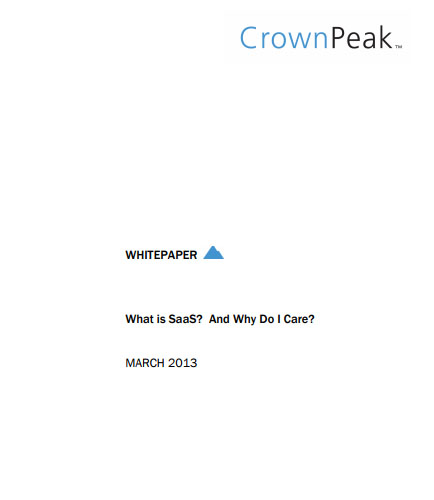
PROCESSING. PLEASE WAIT...

White Paper: CrownPeak
The goal of this descriptive whitepaper is to clarify what SaaS is and help the reader understand why not everything that is called SaaS meets the requirements of a true “Software as a Service” model. It also addresses key questions like:
What is the relationship between SaaS and cloud computing?
What are the core principles which makeup the fundamental building blocks of a SaaS application?
What are the four layers of security which is used to safeguard customer data in a SaaS environment?
What are the business benefits of Web Content Management when combined with the Software as a Service application?
Is SaaS Web Content Management right for your business?
Read this whitepaper on “What is SaaS And Why Do I Care?” that helps digital marketers and technology managers understand the true definition of SaaS, and eliminate preconceived objections about the benefits of a SaaS-based delivery model.

By: Metric Insights
Many healthcare organizations have implemented Business Intelligence (BI) tools for healthcare analytics in the hopes of making their operations data-driven and therefore more effective.Yet,despite the investment of billions in these tools, the technology has under-delivered on its promise. This white paper addresses seven areas on which a healthcare IT organization should focus to ensure success in implementing Push Intelligence: • Provide insights that find the practitioner, not the other way around • Never require users to wait • Personalize delivery of Metrics • Allow Context and Collaboration • Remove training from the equation • Deploy quickly and iterate • Seamlessly interface with existing applications
By: KINGSTAR
OEMs traditionally used DSP-based hardware, plugged into a PC, for motion control. But new software-based solutions have challenged this approach, claiming equal or better performance at lower cost. How does soft motion really compare to hardware? In this whitepaper, we break it down component-by-component for a down-to-the-dollar cost and performance comparison. Topics covered include: Challenges with the traditional hardware approach How soft motion solves those challenges Performance comparison: calculations, axis control, adding axes and machine vision Cost comparison cost and length, ability to scale, necessary hardware Cost-per-item breakdown showing that soft motion costs 44% less than hardware Learn how software-based motion control actually compares to hardware with real-life scenarios and real-dollar cost comparisons. If you’re considering soft motion, start here.


 2025 All Rights Reserved | by: www.ciowhitepapersreview.com
2025 All Rights Reserved | by: www.ciowhitepapersreview.com